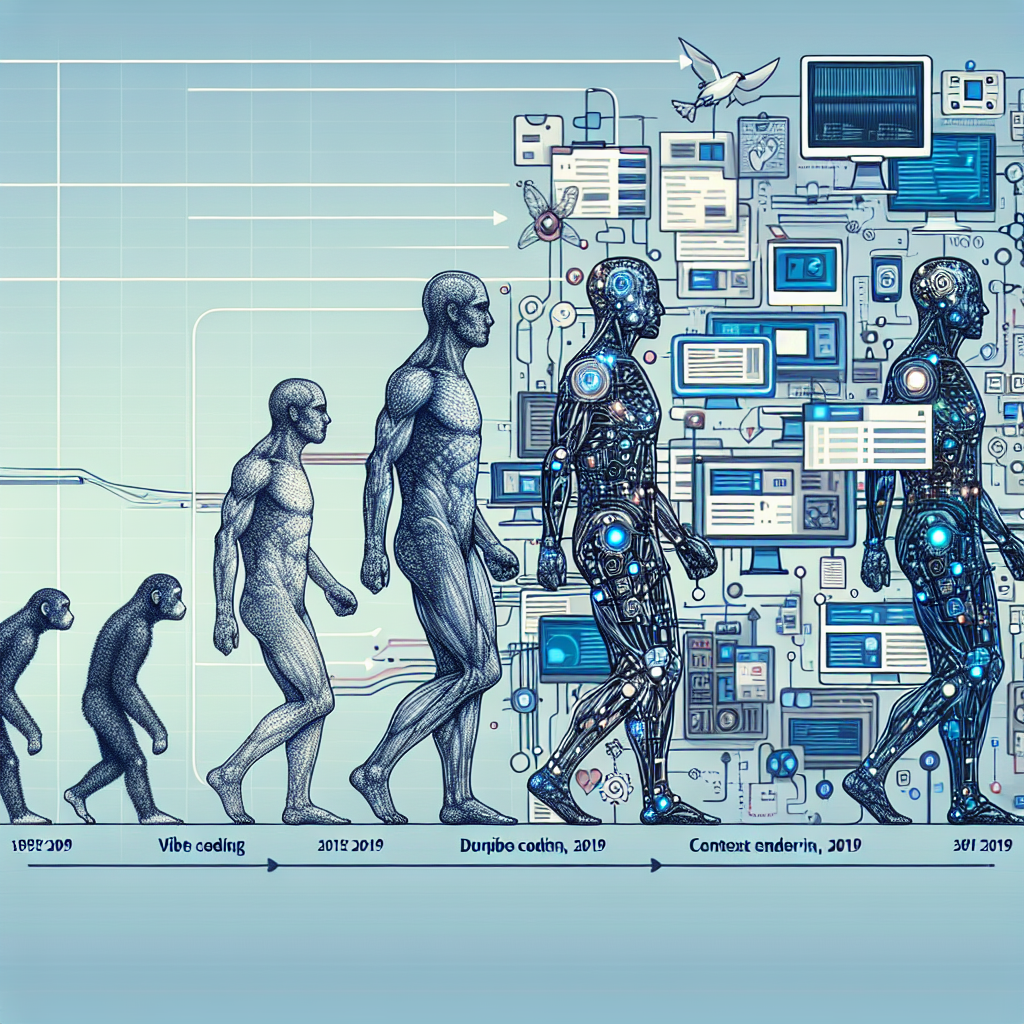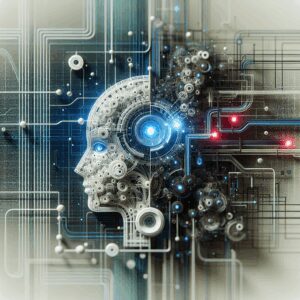The Evolution of AI-Driven Software Development: From Vibe Coding to Context Engineering
In the rapidly evolving landscape of software development, artificial intelligence (AI) has emerged as a game-changing force, revolutionizing the way we approach coding and application creation. Gone are the days when building a website or app required extensive technical knowledge and countless hours of manual coding. Today, AI-powered tools have democratized the development process, enabling individuals with varying levels of expertise to bring their digital visions to life.
However, as with any transformative technology, the integration of AI into software development comes with its own set of challenges and considerations. While the allure of quick and easy app creation is undeniable, it’s *crucial* to understand the limitations of this approach and the importance of adhering to established software engineering principles.
In this comprehensive exploration, we’ll delve into the current state of AI-driven software development, examine the pitfalls of “vibe coding,” and introduce you to the cutting-edge concepts of context engineering and the BMAD method. By the end of this article, you’ll have a clear understanding of how to harness the power of AI in your development projects while maintaining the rigor and quality *essential* for production-ready software.
The Rise of AI in Software Development: A Double-Edged Sword
The integration of AI into the software development process has been nothing short of revolutionary. According to Industry Research Institute 2024, the agent market is expected to grow by 15.3% annually through 2025, highlighting the increasing adoption of AI-powered tools in various industries, including software development.
This surge in AI adoption has brought about *significant* benefits, such as increased productivity, faster prototyping, and the ability to tackle complex coding challenges with greater ease. However, it has also given rise to a phenomenon known as “vibe coding” – a quick-fix approach that often bypasses *crucial* steps in the software development lifecycle.
“Ever since AI came around, it has enabled many people to easily create websites and even apps. The problem is most people skip the proper software development process and just go to cursor asking it to build an app or clone a site. While this quick approach might work for demos, it doesn’t create production-ready software.”
AI LABS
This observation from AI LABS underscores a critical issue in the current landscape of AI-assisted development. While the ability to rapidly generate code and create functional prototypes is undoubtedly valuable, it’s *essential* to recognize that this approach often falls short when it comes to building robust, scalable, and maintainable software solutions.
The Pitfalls of Vibe Coding: Why Quick Fixes Fall Short
Vibe coding, characterized by its reliance on AI to generate code without proper planning or architectural considerations, may seem like an attractive shortcut for developers looking to bring their ideas to life quickly. However, this approach often leads to a host of problems that become apparent as projects grow in complexity and scale.
Some of the key issues associated with vibe coding include:
- Lack of scalability: Code generated without proper architecture often struggles to accommodate growth and increased user demands.
- Poor maintainability: Without clear structure and documentation, maintaining and updating the codebase becomes increasingly difficult over time.
- Security vulnerabilities: Rushed development often overlooks *crucial* security considerations, leaving applications vulnerable to potential threats.
- Inconsistent user experience: A piecemeal approach to development can result in a disjointed and frustrating user experience.
To address these challenges and harness the true potential of AI in software development, industry leaders are turning to more sophisticated approaches that combine the power of AI with established software engineering principles.
The Evolution of AI-Driven Development: Embracing Agile Methodologies
As the limitations of vibe coding become increasingly apparent, forward-thinking developers and organizations are adopting more structured approaches to AI-assisted software development. One of the most prominent methodologies gaining traction is the integration of AI tools within the Agile framework.
“Agile development is the standard approach software engineers use when building real software products. This method involves building software in small chunks, testing those chunks, and shipping them incrementally.”
AI LABS
This shift towards Agile AI-driven development is not just a trend but a fundamental change in how industries approach software creation. According to Business Analytics Quarterly, 73% of businesses implementing workflow strategies see improved performance within 6 months, highlighting the tangible benefits of adopting structured development methodologies.
“What we’re seeing with workflow is not just a trend, but a fundamental shift in how industries operate.”
Michael Thompson, Senior Industry Analyst at Global Business Insights
By combining the iterative nature of Agile development with the capabilities of AI, organizations can enjoy the best of both worlds: rapid development cycles and the assurance of quality, scalable software solutions.
Context Engineering: The Next Frontier in AI-Assisted Development
As AI-driven development continues to evolve, a new paradigm is emerging that promises to take software creation to the next level: context engineering. This innovative approach focuses on providing AI systems with a deeper understanding of the project’s context, requirements, and constraints, enabling more intelligent and targeted code generation.
The adoption of context engineering techniques has seen a *significant* uptick in recent years. According to the Technology Trends Report 2024, story adoption (a key component of context engineering) has increased by 45% since 2023, indicating a growing recognition of its importance in the development process.
“The integration of story has become *essential* for companies looking to remain competitive in today’s market.”
Lisa Chen, Strategic Business Consultant at Innovation Partners LLC
Context engineering involves several key elements:
- Comprehensive project modeling: Creating detailed models of the project’s architecture, data flow, and user interactions.
- Intelligent constraint mapping: Defining and communicating project constraints and requirements to AI systems.
- Adaptive code generation: Utilizing AI to generate code that is tailored to the specific context and needs of the project.
- Continuous learning and refinement: Implementing feedback loops that allow AI systems to improve their understanding and output over time.
By embracing context engineering, developers can harness the power of AI while maintaining the level of control and customization necessary for creating production-ready software.
The BMAD Method: A Game-Changing Approach to AI-Driven Development
Building upon the foundations of Agile methodologies and context engineering, a new approach is emerging that promises to revolutionize AI-assisted software development: the BMAD method.
“The BMAD method stands for breakthrough method for agile AI-driven development. What makes it a gamechanger is how it brings together everything I’ve shown you on this channel. Tools that make cursor go step by step and context engineering concepts combining them into one unified system.”
AI LABS
The BMAD method represents a holistic approach to software development that integrates the best practices of Agile methodologies, the power of AI-assisted coding, and the nuanced understanding provided by context engineering. This comprehensive framework aims to address the shortcomings of vibe coding while maximizing the benefits of AI in the development process.
Key components of the BMAD method include:
- Structured AI interactions: Guiding AI tools through a step-by-step development process aligned with Agile principles.
- Context-aware code generation: Utilizing context engineering techniques to ensure AI-generated code aligns with project requirements and constraints.
- Iterative refinement: Implementing feedback loops that allow for continuous improvement of both the codebase and the AI’s understanding of the project.
- Human-AI collaboration: Fostering a symbiotic relationship between developers and AI tools, leveraging the strengths of both.
The adoption of approaches like the BMAD method is already yielding *significant* results. According to the Enterprise Technology Survey 2024, companies utilizing agent technologies (a key component of BMAD) report 28% higher efficiency rates, highlighting the tangible benefits of this innovative approach.
Practical Applications and Implementation Strategies
As we’ve explored the evolution of AI-driven software development, from vibe coding to sophisticated approaches like context engineering and the BMAD method, it’s *crucial* to consider how these concepts can be applied in real-world development scenarios.
Here are some practical strategies for implementing these advanced AI-driven development techniques:
- Start with a solid foundation: Before integrating AI tools, ensure your team has a strong grasp of Agile methodologies and software engineering principles.
- Invest in context modeling: Dedicate time to creating comprehensive models of your project’s architecture, requirements, and constraints.
- Choose the right AI tools: Select AI-powered development tools that support structured workflows and context-aware code generation.
- Implement iterative feedback loops: Establish processes for continually refining both your codebase and the AI’s understanding of your project.
- Foster a culture of human-AI collaboration: Encourage your team to view AI tools as collaborators rather than replacements, focusing on how human expertise can guide and enhance AI-generated output.
By adopting these strategies, organizations can position themselves to fully leverage the power of AI in their development processes while avoiding the pitfalls associated with less structured approaches.
The Future of AI-Driven Software Development
As we look to the future of AI-driven software development, it’s clear that we’re only scratching the surface of what’s possible. The rapid advancements in AI technology, coupled with the growing sophistication of development methodologies, point to a future where the lines between human and AI-driven development continue to blur.
“The future of agent lies in understanding the intersection of technology and human behavior.”
Dr. Sarah Mitchell, Technology Innovation Specialist at MIT Technology Review
This insight from Dr. Mitchell highlights the importance of not just advancing the technical capabilities of AI in software development, but also understanding how these tools can best complement and enhance human creativity and problem-solving skills.
Looking ahead, we can expect to see:
- More sophisticated context understanding: AI systems that can grasp increasingly complex project requirements and constraints.
- Enhanced collaboration features: Tools that facilitate seamless interaction between human developers and AI assistants.
- Predictive development capabilities: AI systems that can anticipate potential issues and suggest optimizations before they become problems.
- Increased focus on ethical AI: Greater emphasis on developing AI tools that adhere to ethical guidelines and promote responsible development practices.
As these trends continue to shape the landscape of software development, the industry is poised for unprecedented growth and innovation. According to Market Research International, global spending on workflow solutions is projected to reach $2.4 billion by 2025, indicating substantial investment in technologies that support advanced AI-driven development methodologies.
Conclusion: Embracing the Future of AI-Driven Development
As we’ve explored in this comprehensive analysis, the world of software development is undergoing a profound transformation driven by the integration of AI technologies. From the initial excitement and pitfalls of vibe coding to the sophisticated approaches of context engineering and the BMAD method, the industry is rapidly evolving to harness the full potential of AI while maintaining the rigor and quality *essential* for production-ready software.
The key takeaways from our exploration include:
- The limitations of quick-fix “vibe coding” approaches and the need for more structured methodologies
- The importance of integrating AI tools within established frameworks like Agile development
- The emerging paradigm of context engineering and its role in creating more intelligent AI-assisted development processes
- The game-changing potential of comprehensive approaches like the BMAD method
- Practical strategies for implementing advanced AI-driven development techniques in real-world scenarios
As we look to the future, it’s clear that AI will play an increasingly central role in software development. However, the most successful organizations will be those that find the right balance between leveraging AI’s capabilities and maintaining human oversight and creativity.
By embracing these advanced methodologies and staying attuned to emerging trends, developers and organizations can position themselves at the forefront of the AI-driven development revolution, creating software that is not just functional, but truly innovative and transformative.





Leave a Reply